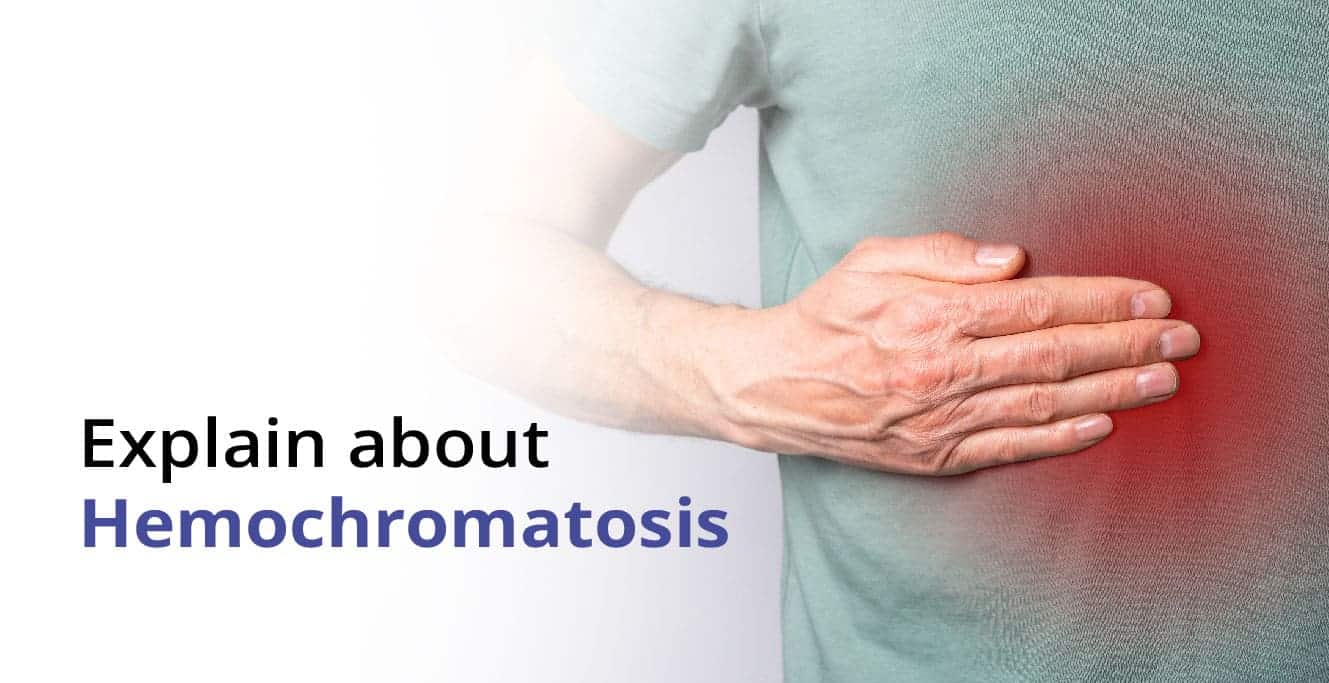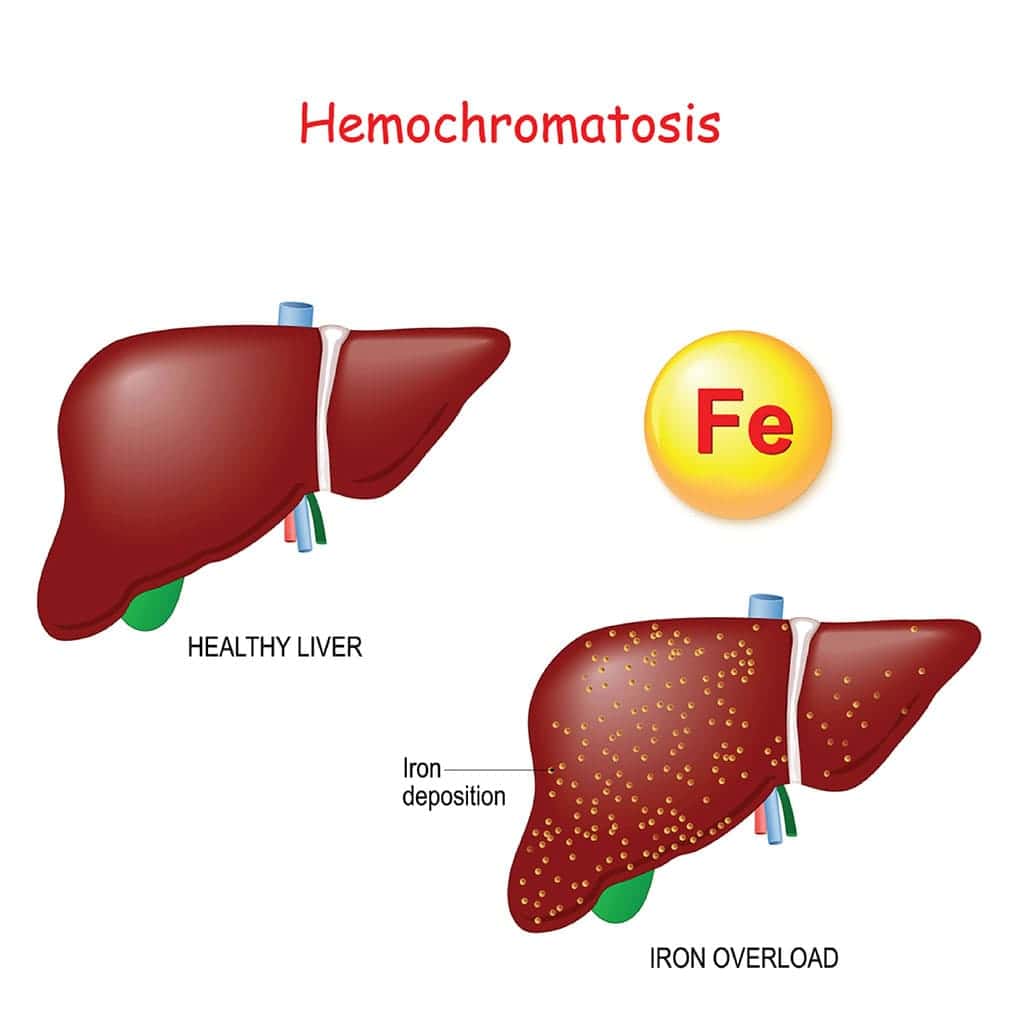Hemochromatosis : Causes, Symptoms & Treatment
- Published on August 09, 2022

Iron is an essential dietary mineral for the body, but like other minerals, high amounts of iron can be harmful. The human body automatically controls the iron level by regulating the iron absorption rate from the digestive tract.
The amount of iron an individual needs depends on various factors like age, sex, predominant diet, etc. Average adult men and women require 18 milligrams of iron in their diet.
Too much iron can be dangerous and cause serious health complications like Arrhythmia, Cirrhosis, Heart failure, Live Failure, and hemochromatosis.
Often, people may not develop noticeable hemochromatosis symptoms during the early stages. However, early diagnosis and hemochromatosis treatment are critical to prevent increased complications.
Table of Contents
What is hemochromatosis?
Hemochromatosis, also known as ‘iron overload’, is a hereditary disorder which leads to an excessive iron build-up in the body.
During the digestion process, normally, the intestines absorb the right amount of iron, but in hemochromatosis, the body absorbs too much iron without being able to get rid of the excess. Excessive iron can damage other parts like joints, hearts, pancreas, endocrine glands, etc.
There are two types of hemochromatosis:
Primary hemochromatosis
It is majorly hereditary and is a result of genetic factors.
The hemochromatosis gene, or the HFE gene, lives on the short arm of chromosome 6. An individual suffering from primary hemochromatosis usually inherits a copy of the flawed gene from each parent. However, not everyone who has the defective gene develops the condition.
Depending on the onset of primary hemochromatosis, it can be further divided into four types:
- Type 1: It is the most common form of primary hemochromatosis and begins in adulthood
- Type 2: It is also known as juvenile-onset disorder and begins in childhood; sometimes it can also begin as late as 20 years old
- Type 3: This is the intermediate type and generally begins somewhere between the age range of type 1 and type 2
- Type 4: This is very similar to type 1 and begins between the ages of 40 and 60
Secondary hemochromatosis
It occurs when excessive iron build-up results from other medical conditions like diabetes, liver diseases, anaemia, frequent blood transfusions, taking excessive supplements, etc.

What are the symptoms of hemochromatosis?
Symptoms of type 1 hemochromatosis, the most common kind, begin between the age range of 30 and 60. Studies reveal that men tend to develop symptoms earlier than women. Women often do not experience symptoms until menopause.
Some of the initial hemochromatosis symptoms are:
- Joint pain
- Sudden weight loss
- Weakness and fatigue
- Nausea
- Fever
- Erectile dysfunction
- Irregular period
As the condition advances, the hemochromatosis symptoms can worsen:
- Low libido or complete loss of sex drive
- Skin darkening
- Yellowing of eyes and skin
- Chest pain
- Difficulty breathing and shortness of breath
- Stiff joints and fingers
- Testicles getting small
- Frequent urge to pee
- Frequent thirstiness
- Abdominal pain
- Abdominal swelling
- Memory fog
- Heart failure
- Diabetes
- Loss of body hair
Also Read: Causes of Infertility in Female
What are the causes of hemochromatosis?
- Family history
Primary hemochromatosis, which is hereditary hemochromatosis, is caused by gene mutations. If an individual inherits the HFE gene from each parent, hemochromatosis is caused. The HFE gene has two common mutations, namely, C282Y and H63D.
If an individual inherits both the genes, i.e., C282Y and H63D, the chances of developing the condition are very high. However, if an individual inherits only one of the mutated genes, they are unlikely to develop the condition.
The individual can still pass the gene to their child. But the child will only develop the condition when an abnormal gene has been inherited from the other parent as well.
- Ethnicity
Studies reveal that people of Northern European ethnicity are more prone to developing hemochromatosis.
In the United States of America, 1 in 300non-Hispanic white people has hereditary hemochromatosis. People with Asian, Hispanic, and Black ethnicity are less prone to hemochromatosis.
- Gender
Women undergo iron loss during the menstruation cycle; hence they are less likely to develop hemochromatosis than men. During pregnancy also, women’s bodies store fewer vitamins and minerals.
Men are more likely to develop symptoms of hemochromatosis by the early or late 30s.
How can hemochromatosis be diagnosed?
If your family has a history of hemochromatosis, we advise you to visit a doctor even if you are not experiencing symptoms. It is better to diagnose hemochromatosis at an early stage and start taking preventive measures as soon as possible.
This way, you will be less likely to develop advanced symptoms in the future.
When you visit a doctor, they will ask about your symptoms and family history. Ensure you are very transparent regarding your family history and other vital information like your predominant diet, any supplements you take, and other health complications.
A doctor may carry out some physical exams to diagnose hemochromatosis.
- Genetic testing
DNA and genetic testing will reveal you have inherited the mutated gene from your parents.
This is very much like a blood test, where the doctor will draw some blood and collect some cells from your mouth using a cotton swab.
- Blood testing
A TS test, i.e., serum transferrin saturation test, is a blood test which measures the level of iron in your blood. It is not a very reliable testing method to diagnose hemochromatosis, but it does help the doctor understand your condition better.
- MRI
Doctors sometimes also suggest non-invasive tests to diagnose hemochromatosis. MRI scan is one technique that allows them to measure the iron level in your body.
- Liver biopsy
During a liver biopsy, the doctor will extract a small piece of tissue from your liver and check its iron levels. The liver is the first organ in the human body which is affected due to excessive iron in the body.
Treatment for hemochromatosis
Timely hemochromatosis treatment will allow you to effectively manage your symptoms and other complications.
Apart from the medical treatment, the patient will also have to undergo some lifestyle changes like having regular blood checks, avoiding supplements, avoiding alcohol, etc.
– Phlebotomy
Phlebotomy is the most common hemochromatosis treatment where your blood is removed regularly to regulate the iron level in the body. It is usually removed three to four times a year.
– Chelation therapy
Chelation therapy involves taking medicine that removes excess iron from your body through excretion. It is not as common as phlebotomy and only done when it is difficult for an individual to have the blood removed regularly due to other health complications.
In Conclusion
Primary hemochromatosis is more common in men as compared to women. Even after making relevant lifestyle changes and early diagnosis, managing the symptoms can sometimes be difficult.
If this is the case with you, reach out to a specialist. To get the best treatment for hemochromatosis, visit Birla Fertility and IVF clinic now and book an appointment with Dr. Prachi Benara.
FAQs:
1. How serious is hemochromatosis?
If diagnosed at an advanced stage, symptoms of hemochromatosis can be difficult to manage. Some of its severe symptoms are liver failure, erectile dysfunction, abdominal swelling, etc.
2. What are the two types of hemochromatosis?
The two major types of hemochromatosis are primary and secondary. Primary is hereditary, whereas secondary is caused due to other health complications like diabetes, liver diseases, heart problems etc.
3. What is Hemochromatosis caused by?
Hemochromatosis is majorly hereditary. It is caused when an individual inherits the HFE gene from both parents.
4. What are the warning signs of hemochromatosis?
Some early warning signs of hemochromatosis are shortness of breath, low libido, weakness, joint pain, weight loss, etc.
Related Posts
Written by:
Dr. Prachi Benara
Consultant
Dr. Prachi Benara is a fertility specialist known for her expertise in advanced laparoscopic and hysteroscopic surgeries, addressing a wide range of conditions including endometriosis, recurrent miscarriage, menstrual disorders, and uterine anomalies like uterine septum. With a wealth of global experience in the field of fertility, she brings advanced expertise to her patients' care.
Over 14+ Years of Experience
Gurgaon – Sector 14, Haryana
Our Services
Fertility Treatments
Problems with fertility are both emotionally and medically challenging. At Birla Fertility & IVF, we focus on providing you with supportive, personalized care at every step of your journey towards becoming a parent.Male Infertility
Male factor infertility accounts for almost 40%-50% of all infertility cases. Decreased sperm function can be the result of genetic, lifestyle, medical or environmental factors. Fortunately, most causes of male factor infertility can be easily diagnosed and treated.We offer a comprehensive range of sperm retrieval procedures and treatments for couples with male factor infertility or sexual dysfunction.
Donor Services
We offer a comprehensive and supportive donor program to our patients who require donor sperm or donor eggs in their fertility treatments. We are partnered with reliable, government authorised banks to source quality assured donor samples which are carefully matched to you based on blood type and physical characteristics.Fertility Preservation
Whether you have made an active decision to delay parenthood or are about to undergo medical treatments that may affect your reproductive health, we can help you explore options to preserve your fertility for the future.Gynaecological Procedures
Some conditions that impact fertility in women such as blocked fallopian tubes, endometriosis, fibroids, and T-shaped uterus may be treatable with surgery. We offer a range of advanced laparoscopic and hysteroscopic procedures to diagnose and treat these issues.Genetics & Diagnostics
Complete range of basic and advanced fertility investigations to diagnose causes of male and female infertility, making way for personalized treatment plans.Fertility Calculators
Empower your journey to parenthood with our fertility calculators. Accurate, personalized guidance for your fertility goals.








































